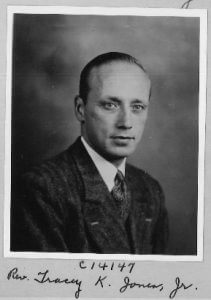Missionary, Executive, Author

The Rev. Tracey K. Jones, Jr., was among the last Christian missionaries to enter China before the country was closed to outside church personnel in 1950. He would serve as head of the United Methodist Board of Global Ministries from 1968 to 1980, and he authored the most widely used mission study book in the history of the denomination.
“Tracey K. Jones, Jr., was a giant of the mission movement of the church,” said Bishop Joel N. Martinez, a past president of the mission agency. “He lived on the mission frontiers and then gave leadership to the whole mission community through his roles in our mission organizations. He was known for his global mission and his ability to communicate that vision to both laity and clergy.”
Betty Thompson, who was on the communications and education staff of the mission agency in Jones’ day, said, “Tracey’s leadership came at a time when new patterns of mission around the world were emerging as colonialism ended. He knew that you did not need to cross salt water to be in mission.”
Jones, the son of Tracey and Marion Flowers Jones, was born in Boston in 1917 and spent his boyhood between Syracuse, New York, and Canton, China. His father was a YMCA missionary and executive. The young Tracey was educated at Mount Hermon Academy, Ohio Wesleyan University, and Yale Divinity School.
He spent his early professional years flying from Delhi, India, to Chungking, China, to work as a liaison between American and Chinese troops. In 1945, he joined a group of Methodist missionaries working in the Nanking area. He witnessed the takeover of China by communist forces, and was able to remain for six months after the change. He joined his wife in Hong Kong for a time, and in the early 1950s was pastor of a Methodist church in Singapore.
Jones returned to the United States in 1955. He joined the staff of the then Board of Missions of The Methodist Church and would become the head of the agency’s World Division and of the entire agency in 1968. He was active in both the National and World Councils of Churches, leading ecumenical delegations to numerous places, including the Middle East.
Jones help to craft the development of The United Methodist Church, formed in 1968 by the union of The Methodist and Evangelical United Brethren churches, and to combine the mission work of the two denominations. This effort came at a time when attitudes about mission were changing and when the civil rights and women’s movements were engaging both church and society.
“Tracey Jones was a firm supporter of opening all doors in the church to people of all racial and ethnic backgrounds,” Thompson said. “And he was a genuine feminist, understanding and appreciating the contributions that women have to make to the church and its mission.”
Jones’ 1963 book, Our Mission Today: The Beginning of a New Age, published by the mission board, sold 300,000 copies, the largest press run of any mission study resource in denominational history.
After his retirement, he served as a professor at Drew Theological Seminary, Madison, New Jersey. His first wife, Martha Clayton Jones, who was also the child of a missionary family, died in 1975. The couple had three children. He later married Junia Moss. Jones died on December 16, 2009.
By Elliott Wright. Elliott Wright is information consultant for Global Ministries. Adapted and supplemented by the author from a Dec. 18, 2009, obituary/profile distributed by the United Methodist News Service.




